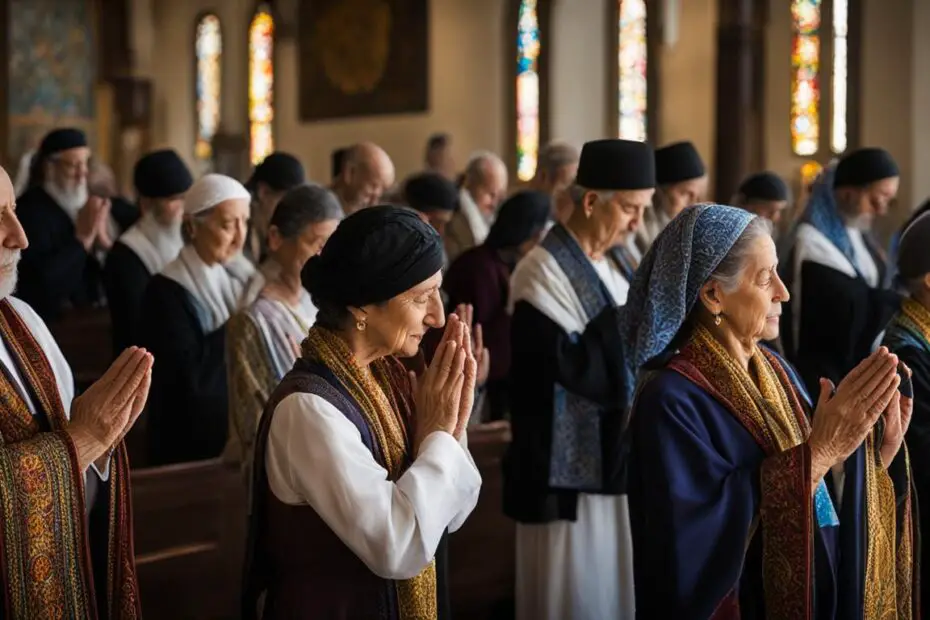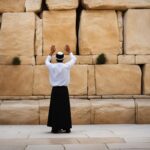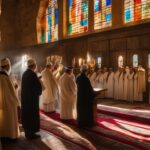Welcome to a journey of discovery as we delve into the rich and meaningful prayer practices of Judaism. In this article, we will explore the gestures, movements, and rituals that enhance the spiritual connection during Jewish prayer. From swaying to standing and bowing, the body becomes an instrument through which the soul finds its voice.
Key Takeaways:
- Jewish prayer practices involve physical gestures and movements that enhance the spiritual experience.
- Swaying, known as shuckling, is a characteristic movement in Jewish prayer that fosters focused intention.
- Standing during specific prayers symbolizes reverence and a deep connection with the Divine.
- Bowing is a gesture of respect and surrender, acknowledging God’s sovereignty.
- The Amidah and the Shema hold significant importance in the Jewish prayer tradition.
Swaying in Prayer: Connecting with the Moment
Swaying, also known as shuckling, is a characteristic movement during Jewish prayer. It involves gently rocking back and forth, putting the body in motion and allowing individuals to be fully present in the moment. By engaging the entire body in prayer, swaying helps to achieve a greater level of focused intention. This physical movement also aligns with the rhythm and flow of the liturgy, allowing individuals to find their personal pace in prayer.
Incorporating swaying into prayer is a way to connect deeply with the Divine. The gentle motion experienced while swaying creates a sense of harmony and tranquility, enabling worshippers to enter into a state of heightened spiritual awareness. Through this rhythmic movement, individuals cultivate a profound sense of focus and concentration.
Shuckling is more than just a physical action; it becomes a conduit for the soul’s expression. As the body sways, thoughts and emotions align, creating a cohesive unity between the mind, body, and spirit. This unity enables individuals to channel their intentions and prayers with clarity and intentionality.
“In the fluid motion of swaying, we find a bridge between the physical and the metaphysical, aligning our entire being with the sacred rhythms of prayer.”
The act of swaying is not limited to a single style or intensity. Each individual brings their own unique expression to this practice, allowing for a diverse range of movements within the communal prayer setting. Some individuals may sway gently side to side, while others may incorporate a circular motion. Regardless of the style, the purpose remains the same – to engage the body in a way that enhances the spiritual connection.
This embodiment of prayer through swaying reflects the holistic nature of Judaism, integrating the physical, emotional, and intellectual aspects of human experience. By involving the body in prayer, swaying serves as a reminder of the interplay between the physical and spiritual realms.
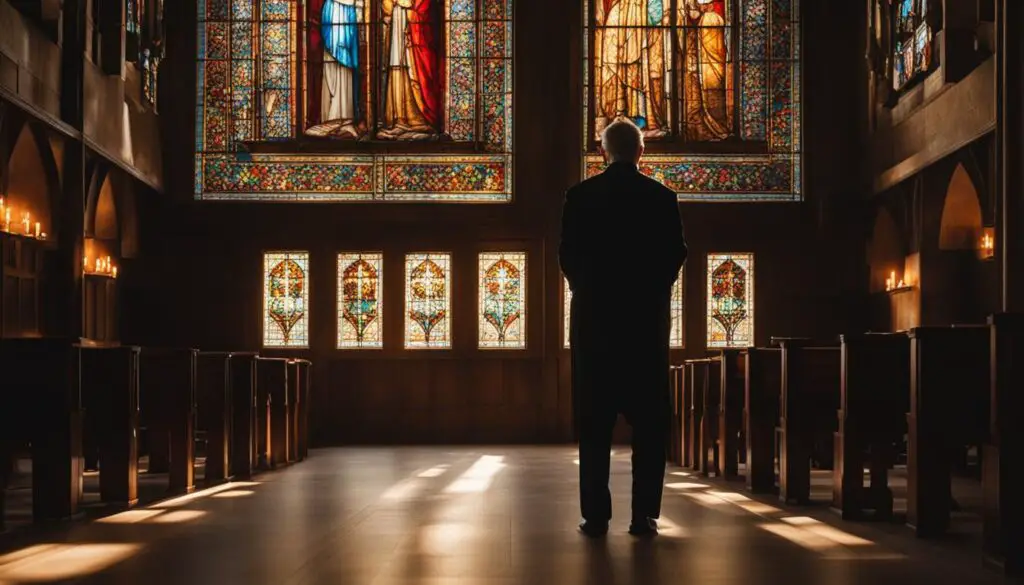
Through the practice of swaying, individuals deepen their connection with the Divine, infusing their prayers with a sense of purpose, focus, and intention. The gentle rocking motion stirs the soul, awakens dormant spiritual energies, and opens the heart to a profound experience of worship.
As we sway in harmony with the prayers of our ancestors, we embody the timeless traditions of Jewish prayer, honoring the past while forging a meaningful path towards the future.
Standing: Reverence and Connection
Standing holds great significance in Jewish prayer, serving as a powerful expression of reverence and a deep connection with the Divine. It is customary to stand during specific prayers and moments in the service, including the Song of the Sea, the Amidah, the K’dushah, the opening and closing of the Ark, Aleinu, and the recitation of Hallel.
By standing during these prayers, worshippers physically elevate themselves, symbolizing their respect and unwavering devotion to God. The act of standing also signifies a readiness to engage in a direct and intimate dialogue with the Divine, creating a deep connection that transcends the physical realm.
Standing in prayer not only embodies a sense of presence and attentiveness but also reflects the belief that the Divine presence surrounds and encompasses worshippers as they engage in spiritual communion. It is a way to express humility, recognizing the awe-inspiring power and grandeur of God.
If we consider the metaphor of standing as a posture of readiness, it reveals a profound spiritual truth. Just as standing requires physical balance and stability, standing in prayer signifies the spiritual balance and stability that come from a deep connection with God. It is a reminder to remain grounded, focused, and open to the Divine presence throughout prayer.
Benefits of Standing in Prayer
Standing in prayer offers numerous benefits, including:
- Creating a sense of reverence and awe
- Promoting a deeper connection with the Divine
- Enhancing mindfulness and focus during prayer
- Encouraging a posture of readiness and spiritual stability
- Fostering a sense of humility and surrender
Bowing: Reverence and Surrender
Bowing is a gesture of reverence and surrender during Jewish prayer. It is a powerful physical expression of respect and acknowledgement of God’s sovereignty. Throughout the service, there are specific moments when individuals bow from the waist, symbolizing their deep reverence for the Divine.
One such moment is at the beginning and end of the first and penultimate blessings of the Amidah. By bowing during these pivotal moments, worshipers demonstrate their submission and devotion to God’s presence in their lives. Additionally, bowing is also observed during Aleinu, a prayer expressing a sense of gratitude and acceptance of God’s role as the ultimate authority.
After bowing, worshipers stand erect, reaffirming their connection with God and embracing the subsequent recitation of God’s holy name. This physical act of bowing followed by standing erect signifies the seamless transition from surrender to renewed presence, acknowledging the eternal link between humanity and the Divine.
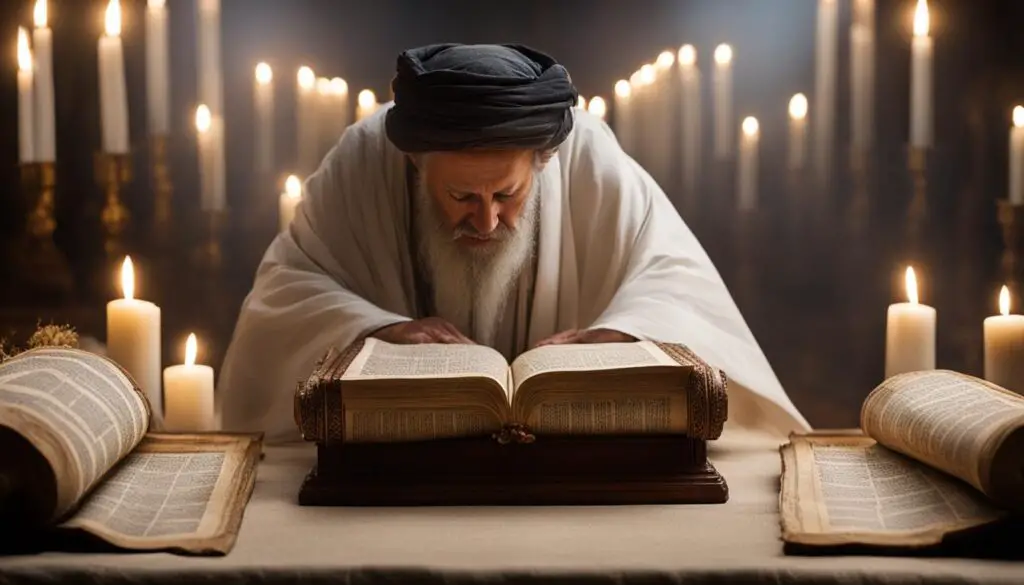
| Moments of Bowing in Jewish Prayer | Relevance |
|---|---|
| The beginning and end of the first and penultimate blessings of the Amidah | Expresses reverence and submission to God’s presence |
| During Aleinu | Signifies gratitude and acceptance of God’s authority |
Choreography of the Amidah: An Act of Approaching God
The Amidah, a central prayer in Judaism, holds a profound significance in fostering a direct connection with God. This sacred prayer is accompanied by specific choreography that symbolizes the act of approaching the Divine with reverence and respect.
When reciting the Amidah, worshipers engage in physical movements that serve as a visual representation of their devotion and awe. The choreography begins with the bowing of the knees at the word “barukh” (blessed) during the opening and penultimate blessings. This act of genuflection acknowledges the sovereignty and holiness of God.
Continuing the choreography, worshipers then bow at the waist while saying “attah” (You) in both the opening and penultimate blessings. This bow, performed with humility and submission, conveys a deep sense of respect and surrender in the presence of the Divine.
Additionally, before reciting the Amidah, worshipers take three steps backward, symbolizing a distance from worldly concerns and a stepping into a sacred space. This physical retreat signifies a moment of awe, preparing individuals to approach God in prayer. Following this, worshipers take three steps forward, signifying a closeness and connection with the Divine.
This choreographed approach to the Amidah prayer creates a sacred rhythm, guiding worshipers on a spiritual journey of approaching God with both humility and intimacy. It elevates the act of prayer from mere words to a deeply embodied experience that engages the mind, body, and spirit.
“The choreography of the Amidah allows us to physically express our reverence and surrender as we approach God in prayer. It is a sacred dance that connects our hearts and souls with the Divine presence.”

| Choreography of the Amidah | Description |
|---|---|
| Bowing of the Knees | Bend the knees at the word “barukh” during the opening and penultimate blessings, symbolizing reverence and acknowledging God’s holiness. |
| Bowing at the Waist | Bow at the waist while saying “attah” during the opening and penultimate blessings, signifying humility, surrender, and respect in the presence of God. |
| Three Steps Backward | Take three steps backward before reciting the Amidah, symbolizing a retreat from worldly concerns and preparing for a sacred encounter with God. |
| Three Steps Forward | Take three steps forward after the retreat, symbolizing a closeness and connection with the Divine. |
The Shema: The Central Affirmation of Judaism
The Shema Yisrael, a pivotal prayer in Judaism, serves as the central affirmation of God’s oneness and singularity. Its recitation twice daily, as part of the morning and evening services, reinforces the unwavering faith of Jewish worshippers. Within the liturgy, the Shema holds immense significance and is regarded as the climactic moment on Yom Kippur, the holiest day in the Jewish calendar. This powerful declaration of faith often accompanies Jews during their final moments, symbolizing a profound connection with God.
Table: Importance of the Shema in Jewish Prayer
| Key Aspects | Significance |
|---|---|
| Belief in God’s Oneness | Declares the fundamental belief in the singularity and unity of God. |
| Twice Daily Recitation | Reinforces faith through consistent affirmation in both morning and evening prayers. |
| Climax of Yom Kippur Liturgy | Represents the pinnacle of devotion and spiritual connection on the holiest day in the Jewish calendar. |
| Powerful in Life and Death | Often recited by Jews during their final moments, reflecting an enduring bond with God. |

The Shema is a proclamation that encapsulates the essence of Judaism, reinforcing the affirmation of God’s oneness and inspiring Jews to live a life devoted to His teachings. It serves as a recurring reminder of the unbreakable bond between the Divine and the Jewish people, calling upon them to fulfill their spiritual responsibilities with unwavering dedication. The recitation of the Shema symbolizes the eternal presence of God in the hearts and minds of His followers.
The Shema: An All-Consuming Love for God
The Shema is more than just a declaration of faith; it is a powerful invocation that calls upon Jews to embrace an all-consuming love for God. This love transcends conditions and demands complete devotion and mindfulness in every aspect of life. It requires individuals to align their thoughts, words, and actions with an intense love for God, ensuring that every aspect of their being is dedicated to the Divine.
This profound and all-consuming love for God is not simply a fleeting emotion but an unyielding devotion that permeates every moment. It beckons individuals to cultivate a deep and unwavering connection to the Divine, infusing their lives with purpose, meaning, and fulfillment.
The Shema serves as a constant reminder of this intense love for God. It is a call to embrace a relationship that goes beyond mere words, inviting individuals to embody faithful devotion in every thought, action, and interaction. Through the Shema, Jews are reminded of the depth and magnitude of God’s love, and in turn, are inspired to reciprocate with an unwavering commitment of their own.
The Shema: An Intrinsic Connection Between Love and Action
The Shema, a profound prayer in Judaism, highlights the inherent bond between love for God and the resulting actions. It calls upon Jews to embrace a deep and unwavering love for God, encompassing every aspect of their being. This love is not limited to emotions alone, but extends to the depths of their thoughts, feelings, and actions.
In the Shema, Jews are instructed to love God with all their heart, soul, and utmost. The term “heart” represents more than just emotions; it encompasses the power of thought and the willingness to accept and internalize God’s teachings. It is a call for complete mindfulness and a genuine connection with the Divine.
The term “soul” signifies not only the individual self but also the life force within. Love for God extends beyond one’s own being and embraces an entire lifetime of devotion. It is rooted in the recognition of the significance of one’s existence and the affirmation of God’s divine presence in every moment.
Lastly, the term “utmost” encompasses one’s strength, wealth, and possessions. It highlights the inseparable connection between love for God and every aspect of life. It is a reminder that love for God should permeate all actions and decisions, both big and small.
Through the Shema, Jews are called to integrate love for God into every facet of their lives. It is an invitation to pursue the art of loving, where thoughts, words, and actions reflect a deep and genuine connection with the Divine. This love fuels a life of devotion, ensuring that every aspect of existence is imbued with the love and reverence for God.
Conclusion
The prayer practices of Judaism are a profound expression of tradition, faith, and spiritual connection. Through gestures like swaying, standing, and bowing, practitioners engage their entire beings in the act of prayer, allowing their bodies to become vehicles for devotion. This embodied practice goes beyond mere words, as it intimately involves the mind, body, and spirit.
By engaging in these prayer practices, Jews cultivate a deep sense of reverence, surrender, and love for God. Each gesture and movement carries symbolic meaning, reflecting a unique pathway to spiritual growth and a profound connection with the Divine. Whether it is the recitation of prayers like the Shema or the choreography of the Amidah, these practices serve as a bridge between the tangible and the intangible, inviting individuals to experience a higher state of consciousness and divine communion.
Through prayer, Jews immerse themselves in a sacred space where the boundaries of the self dissolve, allowing them to feel the presence of the Divine in every moment. It is in this sacred space that individuals can find solace, guidance, and strength to navigate the complexities of life. The prayer practices of Judaism provide a framework for the exploration of profound spiritual truths, offering a path towards enlightenment and a deeper understanding of oneself and one’s relationship with God.
In conclusion, the prayer practices of Judaism are not only a means of communal worship and individual reflection but also a transformative journey towards spiritual connection, growth, and enlightenment. They embody the essence of Jewish faith and tradition, creating a sacred space where the human and the divine intersect, and where individuals can surrender, commune, and experience a profound love for God.
FAQ
What are the prayer practices of Judaism?
The prayer practices of Judaism encompass a variety of gestures and movements, including swaying, standing, and bowing. These physical actions enhance the spiritual connection during prayer and foster a sense of reverence and surrender to the Divine.
What is swaying in Jewish prayer?
Swaying, also known as shuckling, is a characteristic movement during Jewish prayer. It involves gently rocking back and forth, putting the body in motion and allowing individuals to be fully present in the moment. Swaying helps to achieve a greater level of focused intention and aligns with the rhythm and flow of the liturgy.
Why do people stand during Jewish prayer?
Standing plays a significant role in Jewish prayer, particularly during specific prayers and moments in the service. It symbolizes reverence and a deep connection with the Divine. Standing is customary during prayers like the Song of the Sea, the Amidah, and the recitation of Hallel.
What is the significance of bowing in Jewish prayer?
Bowing is a gesture of reverence and surrender during Jewish prayer. It is customary to bow from the waist at certain moments in the service, demonstrating respect and acknowledging God’s sovereignty. After bowing, individuals stand erect upon the subsequent recitation of God’s name.
What is the choreography of the Amidah prayer?
The Amidah, a central prayer in Judaism, has specific choreography that reflects the act of approaching God. Worshipers bow at the beginning and end of the opening and penultimate blessings, bending the knee at the word “barukh” and bowing at the waist while saying “attah.” Additionally, individuals prepare to recite the Amidah by taking three steps backward and then three steps forward, symbolizing both awe and a sense of closeness to God.
What is the significance of the Shema prayer in Judaism?
The Shema is a fundamental prayer in Judaism that declares the belief in the singularity and oneness of God. It is recited daily as part of morning and evening services and holds great significance in Jewish tradition. The Shema serves as a powerful affirmation of faith and is often recited by Jews during their final moments.
What does the Shema teach about love for God?
The Shema emphasizes the connection between love for God and the actions that stem from that love. It calls for Jews to love God with all their heart, soul, and utmost, demanding complete devotion and mindfulness in every aspect of life. The Shema reminds individuals to embrace a deep and unwavering connection to the Divine.
How does the Shema connect love for God to actions in life?
The Shema teaches that love for God should permeate every aspect of life. It calls for thoughts, words, and actions to be aligned with an intense love for God. Love for God encompasses thought and feeling, one’s own being and future generations, and extends to one’s strength, wealth, and possessions. The Shema encourages a holistic approach to living out love for God.
What is the significance of prayer practices in Judaism?
The prayer practices of Judaism are multifaceted and deeply rooted in tradition and faith. Through gestures like swaying, standing, and bowing, as well as the recitation of prayers like the Shema and Amidah, Jews cultivate a profound connection with the Divine. Prayer engages the mind, body, and spirit and serves as a pathway to spiritual growth, fostering reverence, surrender, and love for God.
Source Links
- https://www.exploringjudaism.org/every-day/prayer/understanding-prayer/enhancing-prayer-with-body-movement/
- https://www.brandeis.edu/jewish-experience/holidays-religious-traditions/2022/may/shema-explained-kimelman.html
- https://www.exploringjudaism.org/every-day/prayer/understanding-prayer/the-times-of-day-for-prayer/


